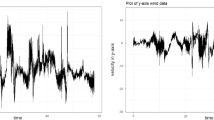Abstract
In this article, general estimating functions for ergodic diffusions sampled at high frequency with noisy observations are presented. The theory is formulated in terms of approximate martingale estimating functions based on local means of the observations, and simple conditions are given for rate optimality. The estimation of the diffusion parameter is faster than the estimation of the drift parameter, and the rate of convergence is classical for the drift parameter but not classical for the diffusion parameter. The link with specific minimum contrast estimators is established, as an example.
Similar content being viewed by others
References
Bibby BM, Sørensen M (1995) Martingale estimation functions for discretely observed diffusion processes. Bernoulli 1(1–2):17–39
Favetto B (2014) Parameter estimation by contrast minimization for noisy observations of a diffusion process. Statistics 48(6):1344–1370
Florens-Zmirou D (1989) Approximate discrete-time schemes for statistics of diffusion processes. Statistics 20(4):547–557
Genon-Catalot V (1990) Maximum contrast estimation for diffusion processes from discrete observations. Statistics 21(1):99–116
Genon-Catalot V, Jacod J (1993) On the estimation of the diffusion coefficient for multi-dimensional diffusion processes. Ann Inst Henri Poincaré Probab Stat 29(1):119–151
Gloter A (2006) Parameter estimation for a discretely observed integrated diffusion process. Scand J Stat 33(1):83–104
Gloter A, Jacod J (2001a) Diffusions with measurement errors. I. Local asymptotic normality. ESAIM Probab Stat 5:225–242 (electronic)
Gloter A, Jacod J (2001b) Diffusions with measurement errors. II. Optimal estimators. ESAIM Probab Stat 5:243–260 (electronic)
Hall P, Heyde CC (1980) Probability and mathematical statistics. Martingale limit theory and its application. Academic Press Inc. [Harcourt Brace Jovanovich Publishers], New York
Jacobsen M (2002) Optimality and small \(\Delta \)-optimality of martingale estimating functions. Bernoulli 8(5):643–668
Jacod J, Li Y, Mykland PA, Podolskij M, Vetter M (2009) Microstructure noise in the continuous case: the pre-averaging approach. Stoch Process Appl 119(7):2249–2276
Kessler M (2000) Simple and explicit estimating functions for a discretely observed diffusion process. Scand J Stat 27(1):65–82
Kessler M, Sørensen M (1999) Estimating equations based on eigenfunctions for a discretely observed diffusion process. Bernoulli 5(2):299–314
Schmisser E (2010) Non-parametric estimation of the diffusion coefficient from noisy data. Preprint MAP5 2010–01: http://hal.archives-ouvertes.fr/hal-00443993
Schmisser E (2011) Nonparametric drift estimation for diffusions from noisy data. Stat Decis 28(2):119–150
Sørensen M (2007) Efficient estimation for ergodic diffusions sampled at high frequency. CREATES Research Paper, (2007–46). http://www.math.ku.dk/~michael/efficient.pdf
Sørensen M (2012) Estimating functions for diffusion-type processes. Stat Methods Stoch differ Equ 124:1–107
Yoshida N (1992) Estimation for diffusion processes from discrete observation. J Multivar Anal 41(2):220–242
Zhang L, Mykland PA, Aït-Sahalia Y (2005) A tale of two time scales: determining integrated volatility with noisy high-frequency data. J Am Stat Assoc 100(472):1394–1411
Acknowledgments
The author wishes to adress many thanks to Pr. Valentine Genon-Catalot, for her help, her advice and suggestions about this article. He thanks also the anonymous referees for their comments and suggestions.
Author information
Authors and Affiliations
Corresponding author
Appendix
Appendix
Define the following random variables which appear in some expansions:
Notice that
Lemma 4
The random variables \(\zeta _{j+1,N}\) and \(\zeta _{j+1,N}'\) are \({{\mathcal {G}}}_{(j+1) \Delta _N}\)-mesurable, and \(\zeta _{j+2,N}'\) is independent of \({{\mathcal {G}}}_{(j+1)\Delta _N}\). Moreover,
In Favetto (2014), several properties of \(Y_{\bullet }^j\) and some results of convergence in probability for functionals of the blocks have been established. Recall that the random variables \(\zeta _{j,N}\) and \(\zeta _{j+1,N}'\) are defined in (4.8), and Lemma 6 is used to establish convergence in probability results.
Proposition 1
Under (A1), we have for \(j \le k_N - 1 \),
with \(|{{\mathbb {E}}}(e_{j,N}' |{{\mathcal {H}}}_j^N )| \le c \Delta _N (1 + |X_{j \Delta _N}|)\) and
If moreover (A5) holds, for \( k \le 8\), there exists \(c > 0\) such that, for \(j \le k_N - 1\):
Proposition 2
Under Assumptions (A1)-(A2) and (A5), we have
where \(\tau _{j,N}\) is \({{\mathcal {H}}}_{j+2}^N\)-mesurable, and there exists a constant c such that
Lemma 5
Assume (A1)-(A3). Let \(f \in \mathcal {C}^1 ({{\mathbb {R}}}\times O )\), where O is an open neighbourhood of \(\varTheta \), satisfy
then:
uniformly in \(\theta \), in probability.
Theorem 6
Assume (A1)-(A5).
-
1.
If \(\delta _N = p_N^{-\alpha }\) with \(\alpha \in (1,2)\) (\(\Delta _N = p_N^{1-\alpha }\)) and (B1) (\(\rho = \rho >0\)), then
$$\begin{aligned} \bar{Q}_N (f(.,\theta )) = \frac{1}{k_N \Delta _N} \sum _{j=1}^{k_N - 2} f (Y_{\bullet }^{j-1} , \theta ) (Y_{\bullet }^{j+1} - Y_{\bullet }^j)^2 \overset{\mathbb {P}}{\longrightarrow } \frac{2}{3} \nu _0 (f(., \theta ) \sigma ^2 ), \end{aligned}$$(20) -
2.
If \(\delta _N = p_N^{-2}\) (\(\Delta _N = \frac{1}{p_N}\)) and (B1) (\(\rho = \rho >0\)), then
$$\begin{aligned} \bar{Q}_N (f(.,\theta )) \overset{\mathbb {P}}{\longrightarrow } \frac{2}{3} \nu _0 (f(., \theta ) \sigma ^2 ) + 2 \rho ^2 \nu _0 (f (. , \theta )), \end{aligned}$$(21) -
3.
If \(\delta _N = p_N^{ - \alpha }\), \( \alpha \in (1,2]\) with (B2) (\(\rho \rightarrow 0\)), then
$$\begin{aligned} \bar{Q}_N (f(.,\theta )) \overset{\mathbb {P}}{\longrightarrow } \frac{2}{3} \nu _0 (f (. , \theta ) \sigma ^2 ), \end{aligned}$$(22)
where all the convergences in probability are uniform in \(\theta \in \varTheta \), as \(N \rightarrow \infty \), with \(\delta _N \rightarrow 0\), \(p_N \rightarrow \infty \), \(k_N \rightarrow \infty \), \(\Delta _N \rightarrow 0\) and \(N \delta _N \rightarrow \infty \).
To study convergences in probability, an auxiliary result from Genon-Catalot and Jacod (1993) is reproduced here.
Lemma 6
Let \(\chi _j^N\), U be random variables, with \(\chi _j^N\) being \({{\mathcal {G}}}_j^N\)-measurable. The following two conditions:
imply \(\sum _{j=0}^{k_N - 1} \chi _j^N \overset{{{\mathbb {P}}}}{\rightarrow } U\).
Rights and permissions
About this article
Cite this article
Favetto, B. Estimating functions for noisy observations of ergodic diffusions. Stat Inference Stoch Process 19, 1–28 (2016). https://doi.org/10.1007/s11203-015-9121-1
Received:
Accepted:
Published:
Issue Date:
DOI: https://doi.org/10.1007/s11203-015-9121-1




